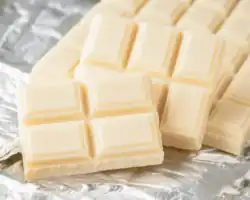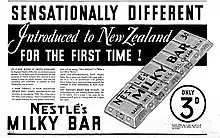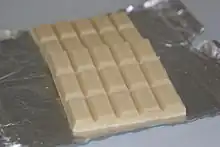 White chocolate tablet | |
| Type | Confectionery |
|---|---|
| Place of origin | Switzerland |
| Created by | Nestlé |
| Invented | 1936 |
| Main ingredients | Cocoa butter, sugar, milk solids |
| Ingredients generally used | Vanilla |
White chocolate is a confectionery typically made of sugar, milk, and cocoa butter, but no cocoa solids. It is pale ivory in color, and lacks many of the compounds found in milk, dark, and other chocolates.[1] It is solid at room temperature (25 °C (77 °F)) because the melting point of cocoa butter, the only white cocoa bean component, is 35 °C (95 °F).[2]
Like the other two main types of chocolate (dark and milk), white chocolate is used for chocolate bars or as a coating in confectionery.
History
As white chocolate is essentially milk chocolate devoid of cocoa solids, it is perhaps noteworthy to recall that the latter was developed in the late 19th century by Daniel Peter and that it quickly became the most popular type of chocolate.[3]

In 1936, the white chocolate tablet Milkybar (or Galak) was launched in Europe by the Swiss company Nestlé,[4] a major player in the Swiss chocolate industry and owner of the Peter-Cailler-Kohler factory.[5] Nestlé is generally credited for the first white chocolate bar, although earlier forms of white chocolate had probably been made before 1936.[6] Making white chocolate was a way to use milk powder and cocoa butter, which were then produced in excess.[7]
White chocolate was first introduced to the United States in 1946 by Frederick E. Hebert of Hebert Candies in Shrewsbury, Massachusetts, near Worcester, after he had tasted "white coat" candies while traveling in Europe.[8][9]
From about 1948 until the 1990s, Nestlé also produced a white chocolate bar with almond pieces, Alpine White, for markets in the United States and Canada.[4] Other chocolate manufacturers developed their own formulas, such as that developed by Kuno Baedeker for the Merckens Chocolate Company in 1945.[10] As white chocolate became mainstream, white versions of popular chocolate bars appeared, for instance Toblerone in 1973[11] and Hershey's Kisses in 1993.[6]
As of 2022, white chocolate accounts for about 10 percent of the overall chocolate market.[12]
Composition
| Nutritional value per 100 g (3.5 oz) | |
|---|---|
| Energy | 2,250 kJ (540 kcal) |
59.2 | |
| Sugars | 59 |
| Dietary fiber | 0.2 g |
32.1 | |
5.87 | |
| Other constituents | Quantity |
| Water | 1.3 g |
| Caffeine | 0 mg |
| Theobromine | 0 mg |
| |
| †Percentages are roughly approximated using US recommendations for adults. Source: USDA FoodData Central | |
White chocolate does not contain cocoa solids, the primary non-fat constituent of conventional chocolate liquor — chocolate in its raw, unsweetened form. These are, however, replaced by milk solids. During manufacturing, the dark-colored solids of the cocoa bean are separated from its fatty content, as with milk chocolate and dark chocolate, but, unlike with other forms of chocolate, no cocoa mass is added back; cocoa butter is the only cocoa ingredient in white chocolate. White chocolate contains only trace amounts of the stimulants theobromine and caffeine which are present in the cocoa mass but not the butter.[13] Flavorings such as vanilla may be added to white chocolate confectionery.[14]
White chocolate is the type of chocolate containing the highest percentage of milk solids, typically around or over 30 percent, while milk chocolate has only around 25 percent.[15]
Variations
Blonde Chocolate
Blonde chocolate is made by slowly heating white chocolate, which gives it a golden color and triggers Maillard reactions in it. These reactions create a range of flavor compounds, contributing to its caramel-like flavor.[16] It was discovered accidentally in 2006 by a chef at Valrhona, who in 2012 were the first company to make it commercially.[17]
Regulations
Regulations govern what may be marketed as white chocolate: Since 2000 in the European Union, white chocolate must be (by weight) at least 20% cocoa butter, 14% total milk solids, and 3.5% milk fat.[18] As of May 2021, the European Food Safety Authority proposed banning the food coloring agent, E171 (titanium dioxide), used as a common whitener in some white chocolate products.[19]
Since 2004 in the United States, the Code of Federal Regulations defined that white chocolate should contain "not less than 20 percent by weight of cacao fat", "not less than 3.5 percent by weight of milkfat and not less than 14 percent by weight of total milk solids", and "not more than 55 percent by weight of a nutritive carbohydrate sweetener."[20] Acceptable dairy elements when manufacturing white chocolate in the United States include evaporated milk, skim milk, buttermilk, or malted milk. White chocolate products may not contain artificial coloring agents.[20]
Vegan versions

Vegan versions of white chocolate chips, bars, and truffles are available from several brands, such as Galaxy and Plamil.[21][22] Some commercial vegan white chocolate substitutes may contain palm oil, which can be an ethical concern for some consumers.[23] Homemade vegan white chocolate can be made using cocoa butter, coconut oil, sugar, and vanilla extract.[23]
See also
References
- ↑ "White chocolate". Bon Appétit. 12 November 2007.
- ↑ "Physical and chemical information on cocoa beans, butter, mass and powder". www.icco.org. Retrieved 2 October 2020.
- ↑ Collins, Ross F. (2022). Chocolate: A Cultural Encyclopedia. ABC-CLIO. p. 310. ISBN 9781440876080.
Milk chocolate grew to become the standard of what the public thought chocolate should be. The old quest for high-quality cocoa beans became less important. Manufacturers instead considered the quality of the milk.
- 1 2 "The history Of white chocolate". The Nibble. The World's Best White Chocolate. 1 April 2008. Retrieved 2 August 2013.
- ↑ "Histoire". Nestlé. Retrieved 24 March 2023.
- 1 2 Renee, Alex (27 January 2022). "The History Of White Chocolate". The Recipe. Retrieved 26 March 2023.
Nestle is primarily credited for marketing the world's first white chocolate bar. However, history shows that previous white chocolate recipes existed, whether by chocolatiers, home cooks, or intended for "medicinal" purposes. [...] America was also blessed with white chocolate, but not until 1948, when Nestle introduced the Alpine White chocolate bar. [...] Then, in 1993, Hershey's hopped on the competition and marketed Hugs, a Hershey's kisses white chocolate variety!
- ↑ Sethi, Simran (27 November 2017). "For those who think white chocolate isn't 'real' chocolate, have we got bars for you". The Washington Post. Retrieved 26 March 2023.
The history of white chocolate is largely unclear, but "the general consensus", says Eagranie Yuh, author of "The Chocolate Tasting Kit" (Chronicle, 2014), "is that Nestlé was the first to develop white chocolate commercially in 1936 in Switzerland. The story is that it was a way to use up excess milk powder that had been produced for World War I and was no longer in demand." [...] White chocolate is also a way to use up extra cocoa butter that is extracted from the cocoa bean when making cocoa powder.
- ↑ Ann Trieger Kurland (26 June 2017). "Hebert Candies marks 100 years of yum". Boston Globe.
- ↑ "Where did the first chocolate factory in the U.S. open?". Travel Trivia. 25 November 2019.
- ↑ "Chocolate-Loving Couple Settled Here" (PDF). Lake Placid News (PDF). Lake Placid, New York. 19 March 1987. p. 8. Retrieved 2 August 2013.
- ↑ Chrystal, Paul (2013). Chocolate: The British Chocolate Industry. Bloomsbury Publishing. p. 68.
Dark Toblerone was launched in 1969 with White Toblerone following in 1973.
- ↑ "White Chocolate: Consumers Take Notice". 6 October 2022. Retrieved 26 March 2023.
- ↑ Zoumas, Barry; Kreisler, Wesley; Martin, Robert (1980). "Theobromine and Caffeine Content of Chocolate Products". Journal of Food Science. 45 (2): 314–316. doi:10.1111/j.1365-2621.1980.tb02603.x.
- ↑ Blumberg, Naomi. "Chocolate". Encyclopædia Britannica Online. Retrieved 28 July 2015.
- ↑ Beckett, Steve T. (2017). Beckett's Industrial Chocolate Manufacture and Use. John Wiley & Sons. p. 498.
Typical recipes for white bar chocolate
- ↑ "Ask the Alchemist #241 — Chocolate Alchemy". Chocolate Alchemy. 22 February 2018. Retrieved 3 October 2023.
- ↑ Filloon, Whitney (9 February 2018). "Caramelized White Chocolate Is for People Who Hate White Chocolate". Eater. Retrieved 3 October 2023.
- ↑ "Directive 2000/36/EC of the European Parliament and of the Council of 23 June 2000 relating to cocoa and chocolate products intended for human consumption". Retrieved 27 October 2010.
- ↑ "EFSA considers E171 food additive no longer safe". European Food Safety Authority. 6 May 2021. Retrieved 7 May 2021.
- 1 2 "Title 21, Chapter I, Subchapter B, Part 163.124 (white chocolate) of the US Code of Federal Regulations". United States Government Publishing Office. 5 May 2021. Retrieved 7 May 2021.
- ↑ Pointing, Charlotte. "Is Vegan White Chocolate a Thing? Yes! (and Here's Where to Buy It)". VegNews.com. Retrieved 2 June 2023.
- ↑ Smith, Rachel (13 April 2022). "We tried Galaxy's new vegan white chocolate and it didn't disappoint!". Vegan Food & Living. Retrieved 2 June 2023.
- 1 2 "How to Make Vegan White Chocolate". Santa Barbara Chocolate. Retrieved 2 June 2023.
External links
 Media related to White chocolate at Wikimedia Commons
Media related to White chocolate at Wikimedia Commons